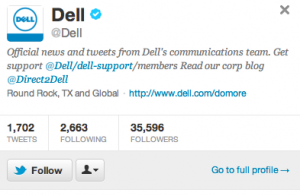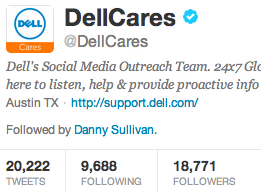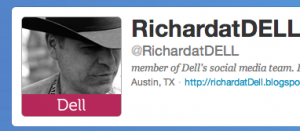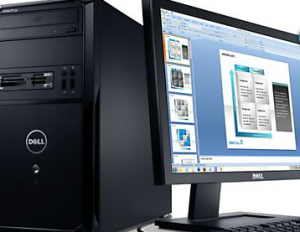Brands
Lessons from Dell’s Dedication on Twitter
This post is part of the Twitter for Brands Series, which features winning strategies from the top brand pages on Twitter and provides tips on how to emulate their successes.
 Dell is dedicated to customer service on Twitter, which explains why the company’s accounts boast millions of followers. The brand uses social media the right way: To connect with people, address their concerns, and participate in meaningful conversations.
Dell is dedicated to customer service on Twitter, which explains why the company’s accounts boast millions of followers. The brand uses social media the right way: To connect with people, address their concerns, and participate in meaningful conversations.
And unlike many companies, Dell finds a way to actually make its Twitter presence profitable. Let’s check out what methods Dell uses to maintain its influence in the Twittersphere.
Setting Up Specific, Targeted Accounts
Dell’s main Twitter page has 35,596 followers and is updated multiple times daily with company news and industry information. The @DellOutlet handle, which lets customers know about deals and discounts, has over 1.5 million followers. When it’s not tweeting about promotions, it’s answering customers’ questions and dealing with issues, often apologizing for less than satisfactory service.
 The account @DellCares, which has 18,771 followers, is strictly for replying to customers and their concerns. There’s also @DellEvents (1,880 followers), which is dedicated to posting about upcoming events and webinars, @Dell4Good (2,025), which focuses on Dell’s corporate responsibility, and @Direct2Dell (18,468), which features headlines from the company’s official blog.
The account @DellCares, which has 18,771 followers, is strictly for replying to customers and their concerns. There’s also @DellEvents (1,880 followers), which is dedicated to posting about upcoming events and webinars, @Dell4Good (2,025), which focuses on Dell’s corporate responsibility, and @Direct2Dell (18,468), which features headlines from the company’s official blog.
As Jennifer Van Grove of Mashable writes, “Dell’s all-hands-on-deck approach to Twitter demonstrates that you need to serve your customers how they want to be served.”
By splitting up accounts, the brand is more effectively reaching its customers. It’s not spamming Twitter feeds with useless information or the company’s replies to disgruntled customers. People have choices when deciding how they want to follow it. What a person in the computer industry cares about may not be what the average customer finds interesting.
Listening to Customers
The fact that Dell has more than one account that deals with customers proves that it takes its relationship with them very seriously. Stefanie Nelson, a program manager at Dell said, “Listening helped us identify gaps and find better ways of meeting customer expectations.”
 She also said that the company’s representatives engage with customers, often in a personal manner and from their own accounts (her handle is @StefanieatDell, for example).
She also said that the company’s representatives engage with customers, often in a personal manner and from their own accounts (her handle is @StefanieatDell, for example).
Responding to questions, lending out useful information, and taking care of issues are top priorities for the company on Twitter.
“Dell’s goal has always been to be an online leader and connect with customers wherever they are,” Senior Manager for Corporate Affairs Richard Binhammer told Mashable. “It starts with listening and connecting with customers across the web. This has proven to be invaluable to our business through the years. We see social media connections as a means to further strengthen those direct customer relationships.”
This strategy helped the company generate $6 million in revenue in 2010. Along with customer engagement, Nelson said that having a clear plan of action that will help “move inventory bubbles quickly.” She also said her company identified its target audience as “price-conscious US residents in the market for a computer.”
Personalization of the Twitter Account
 Blogger Kevin O’Keefe writes that Twitter is a place to build trust and relationships. He says the reason the site “works so well as a both an information moving vehicle and a relationship builder is because we know who is on the other end of the line” through profile pictures, tweets, biographies, and any information someone shares about him or herself.
Blogger Kevin O’Keefe writes that Twitter is a place to build trust and relationships. He says the reason the site “works so well as a both an information moving vehicle and a relationship builder is because we know who is on the other end of the line” through profile pictures, tweets, biographies, and any information someone shares about him or herself.
However, when it’s not clear who is behind a Twitter handle, the trust vanishes, and the relationship will be doomed to fail.
Dell insists that all its employees use handles, just as Nelson does, with the company and their name in it. According to O’Keefe, Binhammer, who is known is @RichardatDell, says the company does this to ensure transparency.
 People don’t want to interact with automated robots, either in person, on the phone, or on social media sites. They appreciate one-on-one conversations and being treated as they would if they were at a Dell store. On the side of every one of Dell’s Twitter accounts is a bar that shows the pictures and initials of the person/people running the page. If customers have issues, they at least can see who they are talking to and feel like their concerns are personally dealt with.
People don’t want to interact with automated robots, either in person, on the phone, or on social media sites. They appreciate one-on-one conversations and being treated as they would if they were at a Dell store. On the side of every one of Dell’s Twitter accounts is a bar that shows the pictures and initials of the person/people running the page. If customers have issues, they at least can see who they are talking to and feel like their concerns are personally dealt with.
“Go where your customers congregate, whether it be Facebook or Twitter or elsewhere, and participate in those conversations,” Binhammer said. “Listen to your customers in the blogosphere. What they have to say is vitally important to your business.”
Get better at your job right now.
Read our monthly newsletter to master content marketing. It’s made for marketers, creators, and everyone in between.




